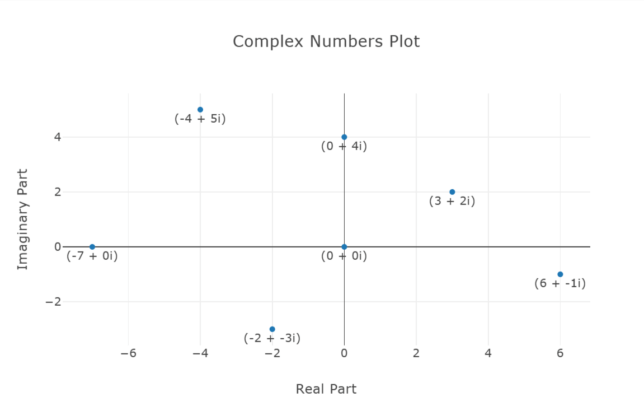Modulus Calculation for Complex Numbers
Calculating the Modulus of $3 + 2i$:
Learn how to calculate the modulus of the complex number $3 + 2i$ step by step:
- Calculate the square of the real part (3): $3^2 = 9$
- Calculate the square of the imaginary part (2): $2^2 = 4$
- Add the squares of the real and imaginary parts: $9 + 4 = 13$
- Take the square root of the sum: $\sqrt{13} \approx 3.60555$
The modulus of $3 + 2i$ is approximately $3.60555$.
Reminder: Do not include “i” when calculating moduli.
Modulus calculation: $\sqrt{3^2 + 2^2} \approx 3.60555$
Calculating the Modulus of $-4 + 5i$:
Learn how to calculate the modulus of the complex number $-4 + 5i$ step by step:
- Calculate the square of the real part (-4): $(-4)^2 = 16$
- Calculate the square of the imaginary part (5): $5^2 = 25$
- Add the squares of the real and imaginary parts: $16 + 25 = 41$
- Take the square root of the sum: $\sqrt{41} \approx 6.40312$
The modulus of $-4 + 5i$ is approximately $6.40312$.
Reminder: Do not include “i” when calculating moduli.
Modulus calculation: $\sqrt{(-4)^2 + 5^2} \approx 6.40312$
Calculating the Modulus of $-2 – 3i$:
Learn how to calculate the modulus of the complex number $-2 – 3i$ step by step:
- Calculate the square of the real part (-2): $(-2)^2 = 4$
- Calculate the square of the imaginary part (-3): $(-3)^2 = 9$
- Add the squares of the real and imaginary parts: $4 + 9 = 13$
- Take the square root of the sum: $\sqrt{13} \approx 3.60555$
The modulus of $-2 – 3i$ is approximately $3.60555$.
Reminder: Do not include “i” when calculating moduli.
Modulus calculation: $\sqrt{(-2)^2 + (-3)^2} \approx 3.60555$
Calculating the Modulus of $2$:
Learn how to calculate the modulus of the complex number $2$ step by step:
- Calculate the square of the real part (2): $2^2 = 4$
- Take the square root of the sum: $\sqrt{4} = 2$
The modulus of $2$ is $2$.
Reminder: Do not include “i” when calculating moduli.
Modulus calculation: $\sqrt{2^2} = 2$
Calculating the Modulus of $2i$:
Learn how to calculate the modulus of the complex number $2i$ step by step:
- Calculate the square of the imaginary part (2): $2^2 = 4$
- Take the square root of the sum: $\sqrt{4} = 2$
The modulus of $2i$ is $2$.
Reminder: Do not include “i” when calculating moduli.
Modulus calculation: $\sqrt{2^2} = 2$
Calculating the Modulus of $-3i$:
Learn how to calculate the modulus of the complex number $-3i$ step by step:
- Calculate the square of the imaginary part (-3): $(-3)^2 = 9$
- Take the square root of the sum: $\sqrt{9} = 3$
The modulus of $-3i$ is $3$.
Reminder: Do not include “i” when calculating moduli.
Modulus calculation: $\sqrt{(-3)^2} = 3$

